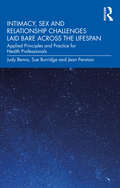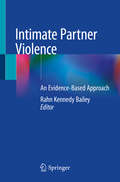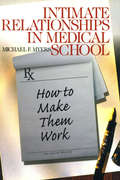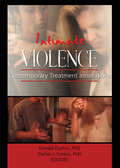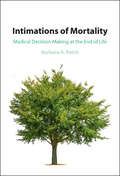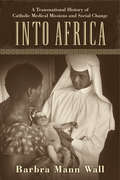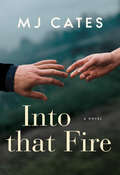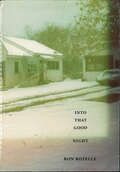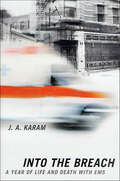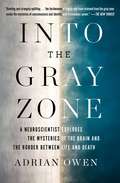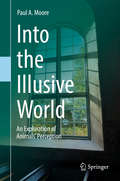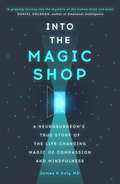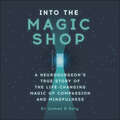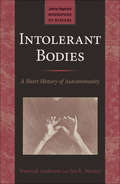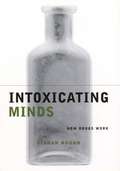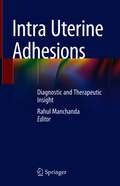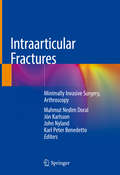- Table View
- List View
Intimacy, Sex and Relationship Challenges Laid Bare Across the Lifespan: Applied Principles and Practice for Health Professionals
by Judy Benns Sue Burridge Jean PenmanThis accessible book uses case studies to explore issues around intimacy, sexual function and sexual development over the lifespan, introducing applied principles and practices when working with sexuality-related issues. Introducing an easy-to-use ‘Reflect and Respond’ model as a framework for interactions, this book discusses a broad selection of topics and life stages, including hidden loss, gender identity, disability, early years experiences and older age. Exposing anonymized real-life experiences of intimacy, sexual function, and sexual development from birth to end of life, this book develops the reader’s insight into sexual wellbeing and confidence in communicating about it. The experiential learning and research-based content in readable style will educate and inspire readers with an interest in sexual wellbeing and how this impacts on physical and mental health. Demonstrating how being open to talk about sex and intimacy can change lives, this guide is suitable for a wide range of health and social care professionals, including nurses, doctors, occupational therapists, social workers, psychologists and counsellors.
Intimate Partner Violence: An Evidence-Based Approach
by Rahn Kennedy BaileyThis book is designed to present a comprehensive and state-of-the-art review of the psychopathology and epidemiology of domestic violence, accompanied by related medical and legal considerations. The introductory sections define domestic violence and its challenges. The major body of the book is devoted to individual topics in various communities and subgroups, covering their behavioral and mental implications. Topics include disparities and special populations, subtypes of offenders, ethical and legal components, impacts of gun ownership, and many other challenges. Each chapter begins with a case study to illustrate the issue presented, concluding with resources and guidelines when available.Intimate Partner Violence is an excellent resource for all clinicians who may encounter victims and perpetrators of domestic violence, including general, child, and forensic psychiatrists, emergency medicine physicians, primary care physicians, pediatricians, psychologists, social workers, school counselors, and all others.
Intimate Relationships in Medical School: How to Make Them Work
by Dr Michael F. MyersIntimate Relationships in Medical School is for anyone studying the medical sciences who is married or in a committed relationship. Michael Myers-an experienced psychiatrist and clinician- uses several case examples throughout the book which are composites from his practice. Through these and the author's suggestions and insights, the busy, committed medical student and his or her partner will increase their ability to confront and resolve misunderstandings.
Intimate Strangers: Commercial Surrogacy in Russia and Ukraine and the Making of Truth
by Veronika SieglZooming in on commercial surrogacy in Russia and Ukraine, Intimate Strangers addresses market expansion into the intimate spheres of life that play out on women's bodies as mothers and workers. Veronika Siegl follows the inner workings of a surrogacy market marked by secrecy, distrust, and anonymous business relationships. She explores intended mothers' anxious struggles for a child in light of stigmatized infertility and the aggressive biopolitics of motherhood; the uncertain but pragmatic pathways in and out of fertility clinics as surrogates navigate harsh economic realities and resist being objectified or morally judged; and the powerful role of agents and doctors who have found a profitable niche in nurturing and facilitating other people's existential hopes. Intimate Strangers discusses these issues against the backdrop of ultra-conservatism and moral governance in Russia, the rising international popularity of the Ukrainian surrogacy market, and the pervasiveness of neo-liberal ideologies and individualized notions of reproductive freedom.
Intimate Violence: Contemporary Treatment Innovations
by Donald Dutton Daniel Jay SonkinTake an updated approach to treating partner violence! Intimate Violence: Contemporary Treatment Innovations examines new and innovative approaches to treating domestic violence, de-emphasizing the unilateral, psychoeducational approach in favor of treatment modalities that focus on the offenders' individual characteristics. The book presents up-to-date information on techniques for working with men and women who commit intimate partner violence, moving past a "one size fits all" mentality to develop treatment that affects long-term changes in beliefs, behaviors, and attitudes. It also includes a brief history of perpetrator treatment, feminist perspectives on treatment, and recent research findings that suggest domestic violence offenders need more than education and attitude adjustment. Intimate Violence explores key treatment issues not usually found in more traditional approaches, particularly shame and attachment. The book focuses on alternate methods based on assessment and tailored to meet the treatment needs of specific populations, including women, lesbian batterers, men with borderline personality disorder (BPD), and Aboriginal men living in Canada. It also examines the Beit Noam, an Israeli live-in intervention program for abusive men, and addresses the legal and ethical issues surrounding the court-mandated treatment of offenders. An international, interdisciplinary panel of practitioners, researchers, and academics also discuss: Dialectical Behavior Therapy (DBT) Physical Aggression Couples Treatment (PACT) attachment theory therapeutically based interventions feminist/social learning treatment individual, group, and integrative therapies transpersonal psychology systems thinking field theory and much more! Intimate Violence: Contemporary Treatment Innovations is an essential resource for clinicians, researchers, educators, and advocates working in psychology, social work, counseling, law, health care, and related disciplines.
Intimations of Mortality: Medical Decision-Making at the End of Life
by Barbara A. ReichIn Intimations of Mortality, Barbara Reich offers an empirically-based critique of the failures of end-of-life communication and decision-making in the United States. Using England and Canada as occasional foils, Reich explores why U.S. physicians, patients, and families struggle to have the conversations necessary to provide seriously ill and dying patients with medical care consistent with their preferences. Reich also shows how a number of different factors –including payment mechanisms, liability fears, cultural phenomena, communication avoidance, death denial, and clinical uncertainty –impact physician-patient communication and medical decision-making, leave patients and families without the tools they need to make informed choices, and instead leave the default practices in place. Ultimately, this groundbreaking analysis unveils the interconnectedness of the many obstacles to better communication and decision-making in end-of-life communications and offers much-needed suggestions for improvement.
Intimiteit en seksualiteit bij dementie (Nursing-Dementiereeks)
by Frans HoogeveenDit boek gaat over intimiteit en seksualiteit bij mensen met dementie en hun partners. Dat zijn algemeen menselijke basisbehoeften, die niet verdwijnen als mensen ouder worden of dementie krijgen. Als die behoeften niet worden vervuld, dan kunnen mensen ongelukkig worden en liggen eenzaamheid, depressie en gedragsproblemen op de loer. Hoe komt het dan toch dat we hieraan zo weinig aandacht besteden in de professionele zorg voor mensen met dementie? En hoe kunnen we dat veranderen?Het boek is ook bedoeld voor partners van mensen met dementie. Ook zij kunnen het moeilijk hebben. Door de dementie verandert de relatie met hun partner en kunnen intimiteit en seksualiteit op de tocht komen te staan. Intimiteit en seksualiteit bij dementie geeft praktische adviezen aan professionals én aan mensen met dementie en hun partners.Inclusief gratis ebook op Mijn BSL met bijbehorende extra’s.
Into Africa: A Transnational History of Catholic Medical Missions and Social Change
by Professor Barbra Mann WallThe most dramatic growth of Christianity in the late twentieth century has occurred in Africa, where Catholic missions have played major roles. But these missions did more than simply convert Africans. Catholic sisters became heavily involved in the Church's health services and eventually in relief and social justice efforts. In Into Africa, Barbra Mann Wall offers a transnational history that reveals how Catholic medical and nursing sisters established relationships between local and international groups, sparking an exchange of ideas that crossed national, religious, gender, and political boundaries. Both a nurse and a historian, Wall explores this intersection of religion, medicine, gender, race, and politics in sub-Saharan Africa, focusing on the years following World War II, a period when European colonial rule was ending and Africans were building new governments, health care institutions, and education systems. She focuses specifically on hospitals, clinics, and schools of nursing in Ghana and Uganda run by the Medical Mission Sisters of Philadelphia; in Nigeria and Uganda by the Irish Medical Missionaries of Mary; in Tanzania by the Maryknoll Sisters of New York; and in Nigeria by a local Nigerian congregation. Wall shows how, although initially somewhat ethnocentric, the sisters gradually developed a deeper understanding of the diverse populations they served. In the process, their medical and nursing work intersected with critical social, political, and cultural debates that continue in Africa today: debates about the role of women in their local societies, the relationship of women to the nursing and medical professions and to the Catholic Church, the obligations countries have to provide care for their citizens, and the role of women in human rights. A groundbreaking contribution to the study of globalization and medicine, Into Africa highlights the importance of transnational partnerships, using the stories of these nuns to enhance the understanding of medical mission work and global change.
Into That Fire
by M. J. CatesFans of Ian McEwan and Paula McLain will fall for this absorbing novel about love and madness, the toll of the First World War and family secrets, and an extraordinary woman's struggle to succeed in a man's world.Imogen is going to hurt Quentin, and she can't bear it. He has been her only friend and confidant during her time at medical school in Chicago, but he wants more than friendship and she doesn't. Unlike most well-brought-up young women in 1916, Imogen does not want to be a wife--she wants to become one of the country's first female psychiatrists. And she has just accepted a residency at the world-leading Phipps Clinic in Baltimore that will take her away from her best friend and toward that future. Quentin is shattered by her rejection, and heads across the border to sign up with the Canadian Expeditionary Force; in one of his only cruel moments, he tells Imogen that he does not have the nerve to kill himself so he'll let the Germans do the job for him. While Quentin encounters unthinkable horrors on the battlefields, Imogen faces her own struggles, whether it is the sexism that constrains her or the barbaric practices that are accepted as treatments and "cures" for the mentally ill. When she's told that Quentin has been killed in France, she falls into a bleak depression over what she has sacrificed to pursue her dream, which eventually leads her to a deeper empathy for her patients and even more passion to find real ways to help them. Soon, her actions in pursuit of that goal put her on a collision course with the powers-that-be. And lead her to a further reckoning with what Quentin means to her. Into That Fire is an engrossing novel about a remarkable woman with a haunted past trying to carve out a winning future for herself. At its heart, it's a love story about uncovering one's true desires.
Into That Good Night
by Ron RozelleWhen his father began to show signs of Alzheimer's disease, Rozelle watched the man's painful transformation into a dependent and ultimately foreign person. In this haunting memoir, Into That Good Night, Rozelle recreates and reclaims the past for his father, offering a son's gift that will echo for a long time to come."The author's skillful and compassionate writing brings both the father of his childhood and the man who could not remember the names of his own children to life. Lester died of a stroke in 1992, but this serves, as his son intended, as a moving tribute." - Publishers Weekly
Into the Abyss: A neuropsychiatrist's notes on troubled minds
by Prof. Anthony DavidWe cannot know how to fix a problem until we understand its causes. But even for some of the most common mental health problems, specialists argue over whether the answers lie in the person&’s biology, their psychology or their circumstances. As a cognitive neuropsychiatrist, Anthony David brings together many fields of enquiry, from social and cognitive psychology to neurology. The key for each patient might be anything from a traumatic memory to a chemical imbalance, an unhealthy way of thinking or a hidden tumour. Patrick believes he is dead. Jennifer's schizophrenia medication helped with her voices but did it cause Parkinson&’s? Emma is in a coma – or is she just refusing to respond? Drawing from Professor David&’s career as a clinician and academic, these fascinating case studies reveal the unique complexity of the human mind, stretching the limits of our understanding.
Into the Breach: A Year of Life and Death with EMS
by J. A. KaramInto the Breach is the true story of paramedics, emergency medical technicians, and heavy-rescue specialists fighting to control trauma and medical emergencies in one of America's toughest and most violent cities: Newark, New Jersey. A riveting account that hauls readers on a first-hand tour of street medicine today, Into the Breach shows what really happens inside an ambulance and some of the diverse and bizarre places EMS workers tread. Through authentic accounts, every facet of emergency care is on display-from the first 911 call to patient discharge or death, including an exclusive look at what is perhaps the biggest decontamination operation ever conducted, which crews performed for victims of the September 11, 2001 terrorist attack. A hybrid profession that blends public safety and public health, EMS attracts careerists and volunteers from all sectors of society-from Boy Scouts and housewives to Fortune 500 vice presidents and work-fare recipients. The men and women that make up the Newark EMS graveyard shift, one of the busiest, full-time teams in the nation, are quintessential EMS workers: intense, irreverent, hard-working action junkies who crave autonomy and the instant gratification of solving critical problems in real time. This unflinching profile hones in on award-winning EMS workers as well as those who pollute the industry, ironically, sometimes one and the same.Into the Breach offers an unusual opportunity to bear witness to unimaginable suffering, heroic stoicism, and the inventiveness of American EMS workers fighting to save lives.
Into the Fire: My Life as a London Firefighter
by Edric Kennedy-Macfoy___________________'Deeply personal and blisteringly powerful.’ Tom Marcus, author of SOLDIER SPYThe incredible true story of life as a London firefighter. What is it really like to be a firefighter? How does it feel to respond to an emergency call, to know that someone's life hangs in the balance and every second is critical?Into the Fire offers an unforgettable insight into the highs and lows of life in the fire service. Chronicling his thirteen-year career in the London Fire Brigade, Edric Kennedy-Macfoy takes us with him from his training days as a new recruit to his very first fire; from call-outs to cannabis farms, chemical spills and trapped swans to the devastating scenes of road traffic collisions, the Croydon tram derailment and the Grenfell Tower fire.Heart-breaking, deeply personal and at times hilarious, this is his remarkable story.
Into the Gray Zone: A Neuroscientist Explores the Border Between Life and Death
by Adrian OwenIn this &“riveting read, meshing memoir with scientific explication&” (Nature), a world-renowned neuroscientist reveals how he learned to communicate with patients in vegetative or &“gray zone&” states and, more importantly, he explains what those interactions tell us about the working of our own brains.&“Vivid, emotional, and thought-provoking&” (Publishers Weekly), Into the Gray Zone takes readers to the edge of a dazzling, humbling frontier in our understanding of the brain: the so-called &“gray zone&” between full consciousness and brain death. People in this middle place have sustained traumatic brain injuries or are the victims of stroke or degenerative diseases, such as Alzheimer&’s and Parkinson&’s. Many are oblivious to the outside world, and their doctors believe they are incapable of thought. But a sizeable number—as many as twenty percent—are experiencing something different: intact minds adrift deep within damaged brains and bodies. An expert in the field, Adrian Owen led a team that, in 2006, discovered this lost population and made medical history. Scientists, physicians, and philosophers have only just begun to grapple with the implications. Following Owen&’s journey of exciting medical discovery, Into the Gray Zone asks some tough and terrifying questions, such as: What is life like for these patients? What can their families and friends do to help them? What are the ethical implications for religious organizations, politicians, the Right to Die movement, and even insurers? And perhaps most intriguing of all: in defining what a life worth living is, are we too concerned with the physical and not giving enough emphasis to the power of thought? What, truly, defines a satisfying life? &“Strangely uplifting…the testimonies of people who have returned from the gray zone evoke the mysteries of consciousness and identity with tremendous power&” (The New Yorker). This book is about the difference between a brain and a mind, a body and a person. Into the Gray Zone is &“a fascinating memoir…reads like a thriller&” (Mail on Sunday).
Into the Illusive World: An Exploration of Animals’ Perception
by Paul A. MooreHave you ever thought about what a dog smells as it stops to sniff at a tree? Or what a cat is watching as it stares intensely off into space? What about animals in the wild? What do they see, hear, smell, and feel? How do they perceive their surroundings? This is the illusive world. A world filled with fascinating stimuli that we are not equipped to detect. This is particularly true because we tend to rely so heavily on our eyes or ears. We are figuratively, and literally, blind to this part of the natural world. This part, which is full of stimuli we cannot perceive, encompasses the daily lives of so many animals. Beneath our feet are ants, moles, and spiders using vibrations to coordinate colonies and communicate danger. In the oceans, turtles, fish, and octopi are sensitive to magnetic and electric fields, as well as tasty morsels at the tips of their tentacles. In the skies, owls and raptors can see deep into a lake or pierce the night with highly sensitive eyes. This book brings together all these animals and their amazing sensory abilities in an exploration of how animals perceive their world. Within these pages are wonderful and exciting stories of organisms using their senses to perform sophisticated communication with nestmates, find hidden prey in the dark of night or murky of depths, and call to lovers both near and far. This book will open the door to this illusive world and will take you on a journey into the illusive world and see how different the world is when perceived through another animal’s senses.
Into the Magic Shop: A neurosurgeon's true story of the life-changing magic of mindfulness and compassion that inspired the hit K-pop band BTS
by Dr James DotyThe award-winning New York Times bestseller that inspired BTS's K-pop song 'Magic Shop'. The day that 12-year-old James Doty walked in to his local magic shop is the day that changed his life. Once the neglected son of an alcoholic father and a mother with chronic depression, he has gone on to become a leading neurosurgeon, based at Stanford University. He credits Ruth for this incredible turnaround: the remarkable woman he met at the Cactus Rabbit Magic Shop, who devoted the summer to transforming his mind and opening his heart.In this uplifting memoir, Jim explains the visualisation techniques Ruth taught him that gave him the self-esteem to imagine a new future for himself. He examines the science behind mindfulness and why the skills he learned - of focus and attention - now help him to think fast and keep calm in the operating theatre. And he shows us what is possible when you start to change your brain and your heart. Into the Magic Shopimparts some powerful life lessons about how to live better, and inspires us to believe that we all have inside us the capacity to change our own destiny.'I'm sure many readers will be moved by this inspiring story to open their hearts and see what they too can do for others' - His Holiness the Dalai Lama
Into the Magic Shop: A neurosurgeon's true story of the life-changing magic of mindfulness and compassion that inspired the hit K-pop band BTS
by Dr James DotyThe award-winning New York Times bestseller that inspired BTS's K-pop song 'Magic Shop'.The day that 12-year-old James Doty walked in to his local magic shop is the day that changed his life. Once the neglected son of an alcoholic father and a mother with chronic depression, he has gone on to become a leading neurosurgeon, based at Stanford University. He credits Ruth for this incredible turnaround: the remarkable woman he met at the Cactus Rabbit Magic Shop, who devoted the summer to transforming his mind and opening his heart.In this uplifting memoir, Jim explains the visualisation techniques Ruth taught him that gave him the self-esteem to imagine a new future for himself. He examines the science behind mindfulness and why the skills he learned - of focus and attention - now help him to think fast and keep calm in the operating theatre. And he shows us what is possible when you start to change your brain and your heart. Into the Magic Shop imparts some powerful life lessons about how to live better, and inspires us to believe that we all have inside us the capacity to change our own destiny.(P) 2020 Blackstone Audio, Inc.
Intolerant Bodies: A Short History of Autoimmunity (Johns Hopkins Biographies of Disease)
by Warwick Anderson Ian R. MackayA history of autoimmunity that validates the experience of patients while challenging assumptions about the distinction between the normal and the pathological.Winner of the NSW Premier's History Award of the Arts NSWAutoimmune diseases, which affect 5 to 10 percent of the population, are as unpredictable in their course as they are paradoxical in their cause. They produce persistent suffering as they follow a drawn-out, often lifelong, pattern of remission and recurrence. Multiple sclerosis, lupus, rheumatoid arthritis, and type 1 diabetes—the diseases considered in this book—are but a handful of the conditions that can develop when the immune system goes awry.Intolerant Bodies is a unique collaboration between Ian Mackay, one of the prominent founders of clinical immunology, and Warwick Anderson, a leading historian of twentieth-century biomedical science. The authors narrate the changing scientific understanding of the cause of autoimmunity and explore the significance of having a disease in which one’s body turns on itself. The book unfolds as a biography of a relatively new concept of pathogenesis, one that was accepted only in the 1950s.In their description of the onset, symptoms, and course of autoimmune diseases, Anderson and Mackay quote from the writings of Charles Dickens, Edgar Allan Poe, Joseph Heller, Flannery O’Connor, and other famous people who commented on or grappled with autoimmune disease. The authors also assess the work of the dedicated researchers and physicians who have struggled to understand the mysteries of autoimmunity. Connecting laboratory research, clinical medicine, social theory, and lived experience, Intolerant Bodies reveals how doctors and patients have come to terms, often reluctantly, with this novel and puzzling mechanism of disease causation.
Intoxicating Minds: How Drugs Work
by Ciaran ReganWhy do smokers claim that the first cigarette of the day is the best? What is the biological basis behind some heavy drinkers' belief that the "hair-of-the-dog" method alleviates the effects of a hangover? Why does marijuana seem to affect ones problem-solving capacity? Intoxicating Minds is, in the author's words, "a grand excavation of drug myth." Neither extolling nor condemning drug use, it is a story of scientific and artistic achievement, war and greed, empires and religions, and lessons for the future. Ciaran Regan looks at each class of drugs, describing the historical evolution of their use, explaining how they work within the brain's neurophysiology, and outlining the basic pharmacology of those substances. From a consideration of the effect of stimulants, such as caffeine and nicotine, and the reasons and consequences of their sudden popularity in the seventeenth century, the book moves to a discussion of more modern stimulants, such as cocaine and ecstasy. In addition, Regan explains how we process memory, the nature of thought disorders, and therapies for treating depression and schizophrenia. Regan then considers psychedelic drugs and their perceived mystical properties and traces the history of placebos to ancient civilizations. Finally, Intoxicating Minds considers the physical consequences of our co-evolution with drugs--how they have altered our very being--and offers a glimpse of the brave new world of drug therapies.
Intoxicating Minds: How Drugs Work (Maps of the Mind)
by Ciaran ReganWhy do smokers claim that the first cigarette of the day is the best? What is the biological basis behind some heavy drinkers' belief that the "hair-of-the-dog" method alleviates the effects of a hangover? Why does marijuana seem to affect ones problem-solving capacity? Intoxicating Minds is, in the author's words, "a grand excavation of drug myth." Neither extolling nor condemning drug use, it is a story of scientific and artistic achievement, war and greed, empires and religions, and lessons for the future. Ciaran Regan looks at each class of drugs, describing the historical evolution of their use, explaining how they work within the brain's neurophysiology, and outlining the basic pharmacology of those substances. From a consideration of the effect of stimulants, such as caffeine and nicotine, and the reasons and consequences of their sudden popularity in the seventeenth century, the book moves to a discussion of more modern stimulants, such as cocaine and ecstasy. In addition, Regan explains how we process memory, the nature of thought disorders, and therapies for treating depression and schizophrenia. Regan then considers psychedelic drugs and their perceived mystical properties and traces the history of placebos to ancient civilizations. Finally, Intoxicating Minds considers the physical consequences of our co-evolution with drugs—how they have altered our very being—and offers a glimpse of the brave new world of drug therapies.
Intoxication: Self, State and Society
by Thomas Thurnell-Read Mark MonaghanWhat images come to mind when you read the word ‘intoxication’? What behaviour do you associate with the word ‘drunk’? When you hear the word ‘drug’, what images do you recall? This textbook provides an essential and thorough grounding in debates about the role of intoxication in contemporary society, from social and cultural perspectives. It examines intoxication in the broadest sense as including both legal and illegal substances and both culturally accepted and socially stigmatised practices. Given the pace of recent changes in policy and practice – from the increasingly common legalisation of cannabis, to the recent trend of sobriety amongst adolescents and young adults – this book stands out by offering both a through historical and theoretical overview and a topical and forward looking exploration of current debates. It adopts a multi-scale approach to examine wider patterns of change so it considers the subjective experiences of the role intoxication plays in the lives of individuals and groups, in the construction of diverse identities and how this differs by age, gender and ethnicity. The authors play particular attention to the way in which the state justifies interventions based on moral, health and criminal justice discourses and also consider the role played by other individuals and institutions, not least the mass media and the alcohol industry, in propagating and challenging common sense explanations of intoxication. It speaks to undergraduates, master's students and above, with a range of pedagogic features, and offers insights into policy and practice.
Intra Uterine Adhesions: Diagnostic and Therapeutic Insight
by Rahul ManchandaThe book covers the entire aspect of intrauterine adhesions and Asherman's syndrome highlighting important points. It discusses etiopathogenesis to diagnosis and the current guidelines with effective treatment policies. It covers new treatment techniques, use of stem cell therapy and various scenarios with the best management of them. The book also covers pregnancy and associated complications. It takes into account the vast clinical experience of the authors all over the world clubbed with the academic evidence available to date.The book is relevant for endoscopic surgeons, hysteroscopists, infertility specialists and obstetricians at large, and anyone who wishes to know more about this subject.
Intra-Abdominal Hypertension
by Manu Malbrain Jan De WaeleDespite increasing interest in intra-abdominal hypertension (IAH) and abdominal compartment syndrome (ACS) as causes of significant morbidity and mortality among the critically ill, unanswered questions cloud the understanding of the pathophysiology of these conditions: • Are IAH and ACS synonymous? • What are the ideal methods of measuring and lowering intra-abdominal pressure (IAP)? • When should we think of IAH? • Can IAH be prevented? • What level of IAP requires abdominal decompression? Written by two experts in critical care and IAP, Intra-Abdominal Hypertension is a distillation of the current literature and furthers the understanding of these complex critical conditions. Using a step-by-step approach and illustrative figures, this clinical handbook presents a concise overview of consensus definitions, measurement methods, organ assessment and treatment options. Intra-Abdominal Hypertension is essential reading for all members of the intensive care multidisciplinary team, including experienced and junior physicians, anesthetists and nurses.
Intra-Operative Neuropathology for the Non-Neuropathologist
by Cynthia T. WelshThis volume acquaints the non-neuropathologist with the advantages of clinical-radiologic-pathologic correlation in neuropathology specimens, particularly in the intra-operative consultation. As a good cytology preparation can add to, or even supply in isolation, a diagnosis, this volume covers the enormous and sometimes insurmountable artifacts involved with freezing tissue, especially central nervous system tissue. The text presents how to perform, and stain the cytologic preparations, and how to interpret them. The advantages and disadvantages of both frozen sections and cytologic preparations of various kinds are discussed. The presentation and format is very visual with diagrams, tables, with many figures including pearls and pitfalls and therefore easy reading. An introductory chapter presents the pros and cons of cytology, the advantages and disadvantages of frozen sections, and the artifacts in both. Also included is an argument for knowing what the scans reveal, and the impact of relevant patient history. The volume uses a case-based approach to show correlation between scan, history, frozen section and cytologic preparations. With the combination of extensive correlation of scans, cytology, and frozen section with differential diagnosis, and analysis of the information crucial to the neurosurgeon in a case-based approach and with a special chapter written by a neuroradiologist, this volume is unique in presentation and utility and will be of great value to the trainee in pathology (residents/fellows), and practicing pathologists who include neuropathology in their practice, but do not have formal fellowship training in neuropathology.
Intraarticular Fractures: Minimally Invasive Surgery, Arthroscopy
by Mahmut Nedim Doral Jón Karlsson John Nyland Karl Peter BenedettoThis superbly illustrated book is a comprehensive and detailed guide to the contemporary arthroscopic management of intraarticular fractures. The opening section addresses a variety of basic aspects and key issues, including the difficulties posed by intraarticular fractures, principles of fixation, cartilage healing, and rehabilitation. The minimally invasive surgical techniques appropriate to individual types of fracture are then fully described and depicted, covering fractures of the shoulder and elbow, wrist, pelvis and hip, knee, and ankle. Guidance is also provided on avoidance and management of complications and rehabilitation. The closing section addresses relevant miscellaneous issues, including arthroscopic management of temporomandibular joint fractures and extended indications for endoscopy-assisted fracture fixation. This volume will be of value for both trainee and experienced surgeons when treating patients with these complex fractures.
